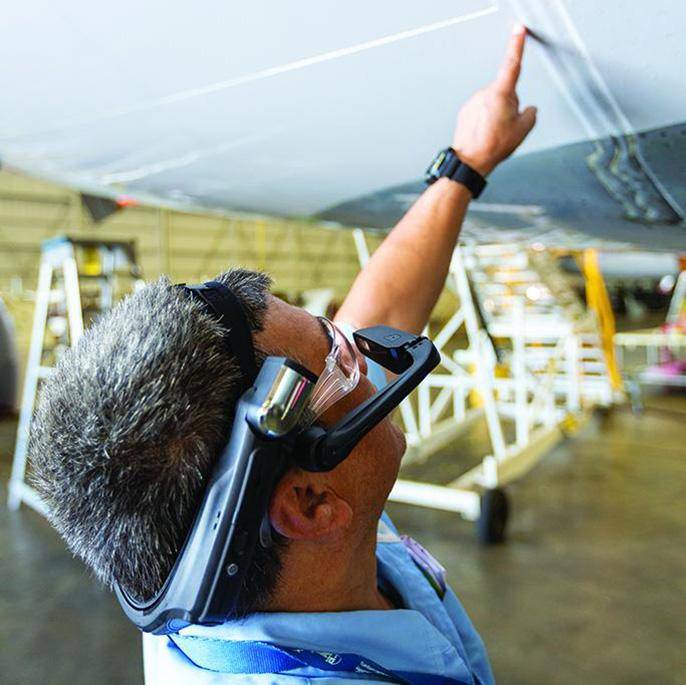AAR says its pilot projects of new technologies such as drones and augmented reality (AR) wearables have proved to be advantageous during the COVID-19 crisis. The technologies, which are being tested at its Miami, Florida facility, were initially implemented as a way to improve efficiencies, but their remote collaboration capabilities have come in handy as a way to effectively social distance.
The Miami facility invested in RealWear’s HMT-1 headsets and Librestream’s AR platform for tasks such as hands-free workflow and collaboration with remote experts. Now, the technology is being leveraged to conduct remote audits with the FAA at various AAR facilities. According to Brian Sartain, AAR’s senior vice president repair and engineering services, technicians wearing RealWear headsets with wireless cameras are able to walk around a facility while in communication with the FAA to take them through a virtual audit of what they want to look at, so FAA experts do not need to come on-site.
“We’ve done some testing with that same wearable technology to limit the amount of time a person—let’s say an engineer who might be working from home—has to actually come onto the floor and into a facility,” says Sartain. “A hangar being an essential workplace and the way that the work is done there, a majority of the employees are still coming to work, but [for] those who can’t or have special conditions, we’re encouraging them to stay home and then we can use all of the technology that we have available to us.”
 Credit: AAR
Credit: AAR
AAR has been using a Donecle drone to test general visual inspections of Boeing 737 aircraft. In addition to reducing the time and amount of staff needed to conduct inspections, the drones are able to take 1,500-1,900 pictures per narrowbody aircraft, which can be sent to FAA inspectors as part of the certification process for the technology.
Meanwhile, the Miami facility is also using Zoom for meetings and limiting class sizes for all technical training. According to Brian Loomer, VP and general manager of AAR’s Miami facility, plans are in place to teach a Boeing 737MAX class via Zoom so training can take place in multiple classrooms at once, which will keep class sizes to maximum of 2-3 people per classroom.
The site has been following CDC guidelines for limiting the transmission of COVID-19, including taking temperatures, wearing masks, using plexiglass dividers for break and lunch tables and sanitizing high-use areas with an atomizer gun. The atomizer gun is also being used to spray down aircraft interiors upon their arrival and departure.
“We’ve adopted stricter than CDC guidelines for contact tracing and quarantine, and when we do find a case, we don’t have workplace transmission present,” notes Sartain. “99% of the cases that we’ve seen among our employee base are actually coming from activities they’ve taken on outside of work and we’ve been able to screen and ensure that from coming into the facility.”
Sartain expects protocols and technologies implemented during the pandemic to continue in some form moving forward. “When we talked to other corporate leaders, many of them are considering what a ‘headquarters building’ actually looks like going forward because they’re seeing that many jobs can be performed remotely. Maybe they don’t have to pay so much in rent. It’s going to be the same in the hangar,” says Sartain.
“Desperation often breeds innovation, and when you can’t get the job done, you figure out a way to do it. Sometimes, those ways are more efficient than in the past, so I think you’ll see increased use of the wearable technology especially to help us build back our network in a more efficient way,” he adds.
While Zoom meetings have their disadvantages, Sartain says there have been some positives as well. “People are readily available. You can put some people together that in a normal circumstance you couldn’t,” and everyone can see each other through the platform, says Sartain. “I think you’ll also see, really for our corporate folks, a really different footprint from an office standpoint.”